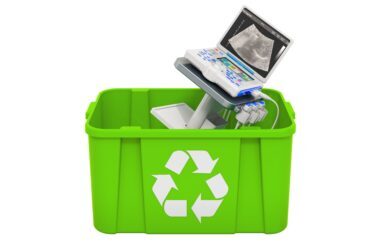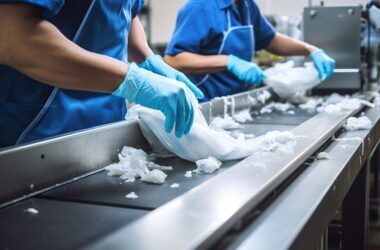The medical device industry is a cornerstone of modern healthcare, providing life-saving equipment and tools for diagnosis and treatment. However, this progress comes with a footprint. Traditional, linear production models generate significant waste, with many medical devices ending up in landfills after a single use. This raises a crucial question: How to recycle medical devices and transition towards a circular economy in healthcare?
The Challenge? Linear Production And Medical Waste
The current medical device industry operates on a linear model. Resources are extracted, materials are processed, devices are manufactured, used once (or a few times), and then discarded. This linear approach creates a significant burden. Here’s why:
- Environmental Impact: Manufacturing medical devices often involves energy-intensive processes and generates air and water pollution. Disposing of them in landfills contributes to greenhouse gasses and takes up valuable space.
- Resource Depletion: Many medical devices contain valuable materials like metals and plastics. Landfilling them depletes these finite resources.
- Inefficiency: Discarded devices often have remaining functionality or can be refurbished. Throwing them away signifies a missed opportunity for reuse.
The Solution? Embracing Circularity In Medical Devices
Circular sustainability for medical devices offers a transformative approach. It has the key to how to recycle medical devices effectively. Further, it emphasizes keeping resources in use for as long as possible, reducing waste, and maximizing resource recovery. Here’s how it translates to the medical device industry:
- Design For Disassembly: Manufacturers can design devices with easy disassembly in mind. This allows for the separation of components and facilitates material recovery at the end of a device’s life cycle.
- Reprocessing And Reuse: Functional devices can be reprocessed and reused after proper cleaning, disinfection, and testing. This extends their lifespan and reduces the need for virgin materials.
- Recycling: When devices reach the end of their usable life, recycling recovers valuable materials like plastics and metals. These materials can be used in the production of new devices, closing the loop.
- Remanufacturing: Certain devices can be remanufactured by replacing worn-out parts with new ones. This creates high-quality, functional devices at a lower environmental cost.
- Take-Back Programs: Manufacturers can initiate take-back programs where used devices are collected and processed for reuse, reprocessing, or recycling.
- Regulation And Standards: Developing clear regulations and standards for device reprocessing, remanufacturing, and recycling is crucial. This ensures patient safety and facilitates the smooth operation of a circular system.
- Logistics And Infrastructure: A robust infrastructure for collecting, sorting, and processing used medical devices is essential. Investments in logistics and recycling facilities are necessary.
- Cost And Investment: Transitioning to circular practices might need direct investments in new technologies and infrastructure. Collaboration between stakeholders can help distribute these costs effectively.
- Consumer Acceptance: Raising awareness about the safety and efficacy of reprocessed and remanufactured devices is crucial.
Educational campaigns can inform healthcare professionals and patients about the rigorous testing and regulatory oversight involved in these processes. Highlighting the environmental and economic benefits of circularity can further encourage adoption.
Benefits Of A Circular Medical Device Industry
Transitioning to a circular economy in medical devices offers numerous benefits:
- Environmental Sustainability: Reduced reliance on virgin materials, lower energy consumption during production, and minimized landfill waste contribute to a more sustainable healthcare system.
- Cost Reduction: Reprocessing, reuse, and recycling can significantly reduce manufacturing costs for medical devices. These savings can be passed on to hospitals and patients.
- Resource Security: Circularity ensures a steady supply of materials for device production, mitigating the risks associated with resource depletion.
- Innovation: The focus on designing for disassembly and remanufacturing encourages innovation in materials science and device design.
Promoting Innovation – A Catalyst For Circularity
Innovation plays a central role in driving a circular medical device industry. Here are some key areas for advancement:
- Biocompatible And Recyclable Materials: Developing new materials that are biocompatible, durable, and readily recyclable is crucial. Research in bioplastics and biodegradable polymers holds significant promise.
- Design For Disassembly And Remanufacturing: Manufacturers can invest in design innovations that facilitate easy disassembly and component replacement. This allows for efficient remanufacturing and extends the lifespan of devices.
- Digital Technologies For Tracking And Traceability: Implementing digital solutions for tracking and tracing medical devices throughout their lifecycle can improve efficiency in collection, sorting, and reprocessing. Blockchain technology can offer secure and transparent data management.
How You Can Get Involved?
As a healthcare professional, patient, or concerned citizen, you can play a role in promoting circularity in medical devices:
- Ask Questions: When purchasing medical devices, inquire about the manufacturer’s sustainability practices, including take-back programs and recycling initiatives.
- Support Sustainable Companies: Choose medical device providers committed to circularity. Look for companies offering remanufactured devices or those with well-defined take-back programs.
- Advocate For Change: Raise awareness about the necessity of medical device recycling and the benefits of a circular healthcare economy. You can do this by talking to colleagues, patients, and policymakers.
The Road To A Circular Future
Transitioning to a circular medical device industry requires collaboration. Manufacturers, healthcare providers, policymakers, and patients all play a crucial role. By collaborating together, we can create a more sustainable healthcare system that minimizes waste, maximizes resource recovery, and stimulates continuous innovation.
Adopting circularity doesn’t just answer your question about: how to recycle medical devices but benefits the environment, strengthens healthcare systems, and ensures a healthier future for all. Let’s collectively move towards a circular medical device industry, one recycled device at a time.
[Related Read: Streamlining Medical Supply Chain With Sustainable Aviation Fuel]













